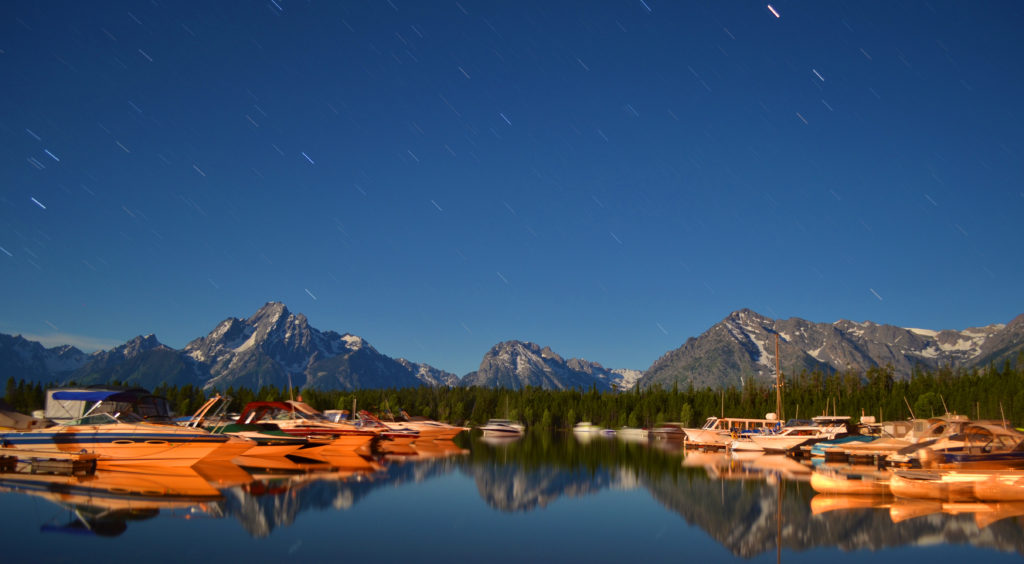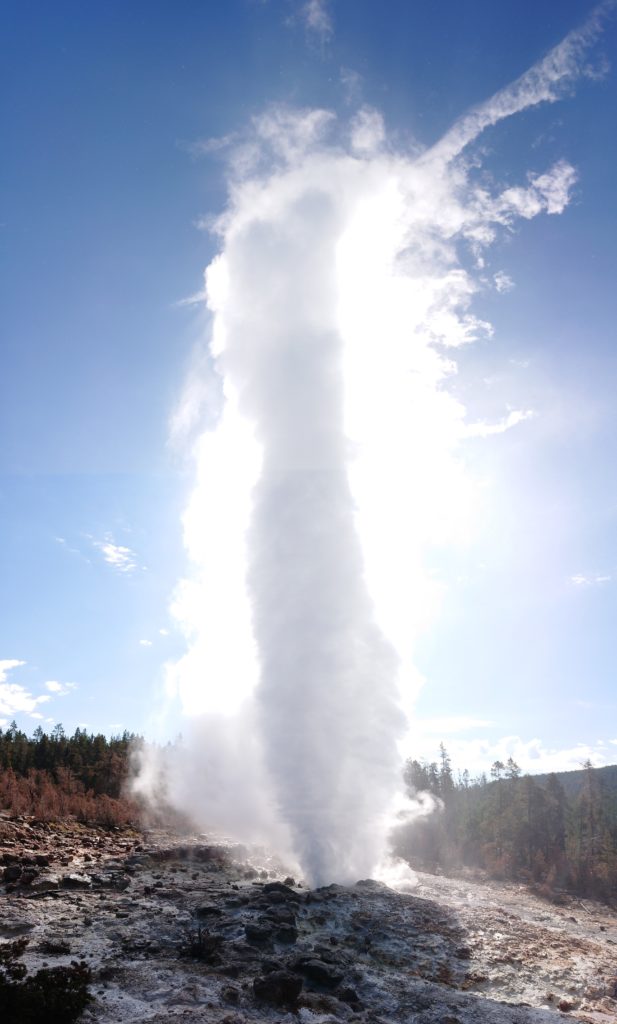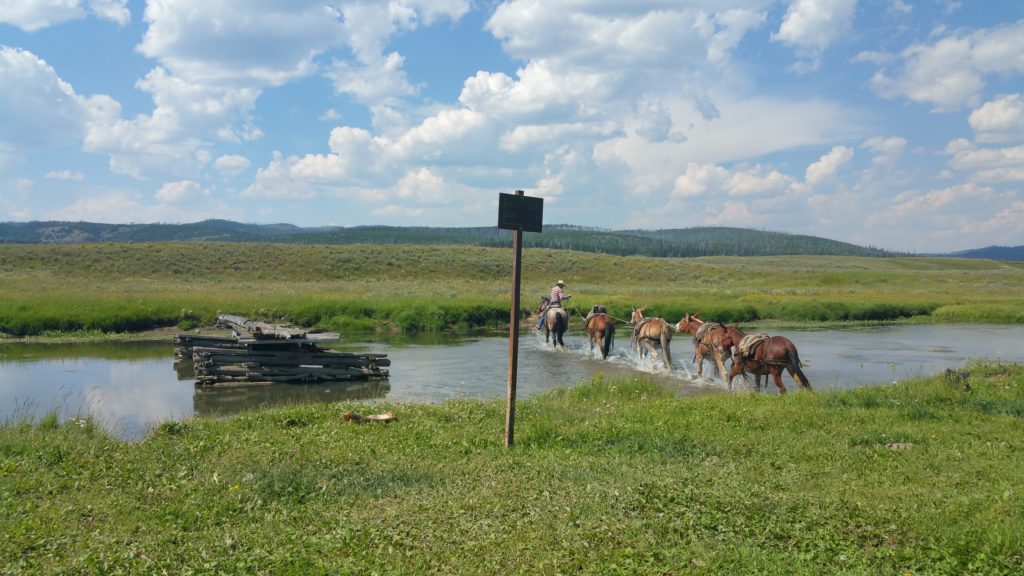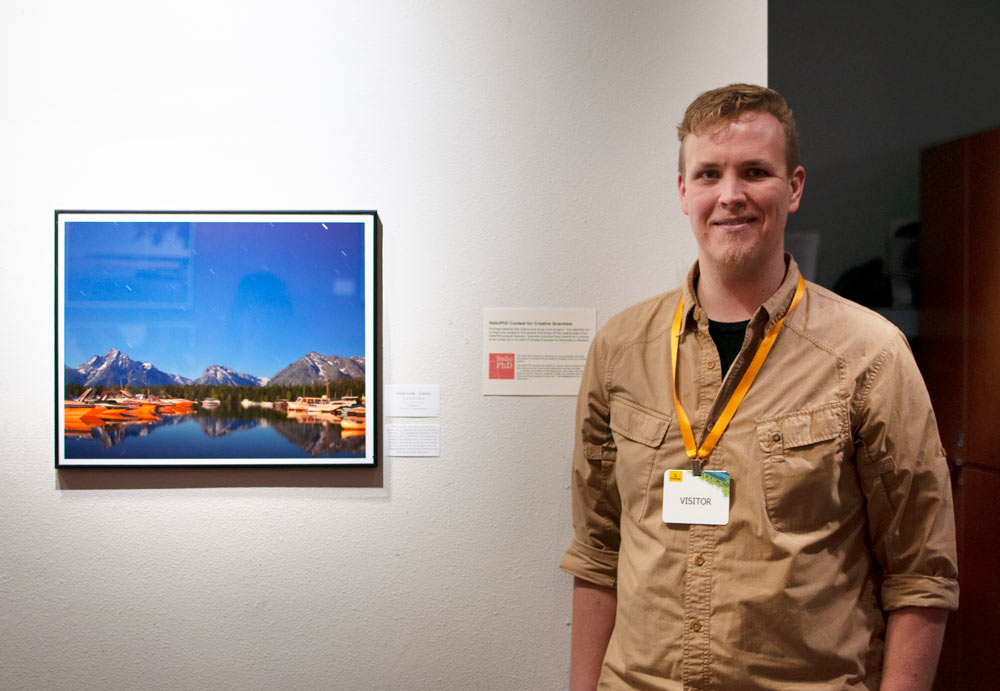Today’s article is written by guest blogger Vince Debes, this year’s winner of the Promega Art Contest for Creative Scientists. He will be starting a Master of Science program in Geological Sciences in the School of Earth and Space Exploration at Arizona State University this fall.

It’s incredible how seemingly insignificant actions can lead to major events years down the road. When my partner and I were testing out our new camera shutter remotes in the Grand Tetons on the way to do field work in Yellowstone, I never imagined an image we captured would lead to a grand prize in the Promega Art Contest for Creative Scientists. The four-minute-long exposure was taken at midnight with a full moon and shows the ghostly, almost imperceptible, movements of Colter Bay marina vessels against a backdrop of trailing stars and the stolid Tetons.
Looking at the broad strokes, that image could represent the Yellowstone thermal system over geologic time. Snow melt in the northern mountains feeds the hydrothermal system and some hot springs show yearly seasonal variations in composition and temperature, like the movement of the boats. Other thermal features, with water taking around 500 years to percolate through the rock and reach the surface, seem constant through the seasons but are gradually changing on longer timescales, much like weathering of the majestic Tetons. And like stars, appearing fixed when you briefly look up at them but trailing when you increase exposure times, the Yellowstone hot spot is shifting northeast as the continental plate moves over millions of years.

I work with Everett Shock in the interdisciplinary Group Exploring Organic Processes In Geochemistry (GEOPIG) at Arizona State University. Our overarching goal is to connect geological processes, subsurface water/rock/gas reactions and spatial chemical variability in fluids to microbial diversity and function in order to model life on early Earth and question what life might look like on other planets.
Our collaborator at Montana State University, Dan Colman, came up with a great analogy comparing what we study to gastronomy. If you imagine a hot spring as a restaurant, you can assign different aspects of the dining experience to each part of our research.
The picky patrons are microbes living in the springs and each member of the community could have a different metabolism. Some prefer to consume methane, while others oxidize iron or sulfide, and the list goes on. If we translate that into gastronomical terms, you could have a vegan, a vegetarian and someone following the paleo diet all going out to dinner together. If they decide to go to a vegan restaurant, the paleo person will likely be able to find some sort of sustenance; however, if they choose to go to a Brazilian steak house, the vegan and vegetarian will have very limited choices for dinner. A restaurant that would likely support all of the patrons would offer multiple choices, like Chipotle.
The restaurant menu is reflective of the patrons who eat there. If we can measure the amount of hydrogen, iron, sulfate, nitrate, etc. in a hot spring restaurant, we can learn more about the sort of microbes that live there. The chef who builds the menu out of seasonal food or what the vendor provides is akin to the geological processes that occur over thousands to millions of years and drive the chemistry of the hot spring fluid.
My fellow field scientists and I are essentially food critics, striving to understand the process of how the food is transported to the chef, how the chef builds the menu and then how the patrons react to their dinner. In order to do this, we need to go to the field and sample the microbes in their natural environment, combined with thermodynamic modelling and other lab analyses. Field sampling is one of my favorite parts of the process because you get to actually see variation with your own eyes and insert your experience into the larger ecological framework. Taking a step back to look at the consequences of the entire natural system can provide perspective and direction in your day-to-day lab work.

If you want to learn more about field work, including what a typical day looks like and stories from the back country, I was recently interviewed by Daniel Arneman for an upcoming HelloPhD podcast episode. Daniel and his cohost Josh Hall do an awesome job talking about the lesser known aspects of academia and graduate school life, and they certainly made my life easier when I was applying to my graduate program. HelloPhD also gave me the incredible opportunity to have my photo displayed and visit the welcoming people of Promega—the Art Contest is exclusive to listeners of the podcast.
Having never visited a biotech company before, I honestly didn’t know what to expect, but pleasant surprises were around every corner of Promega’s beautiful Madison, Wisconsin campus! The main building is reminiscent of a large cabin with incredible wooden architecture and art pieces spread throughout the two floors. Teaching labs and demonstration areas are seamlessly integrated into the building so you could be in a conference room one minute, peering into to a sterile white lab space the next, and ending your walk overlooking a two-story tall indoor plant wall.
Jenny Loeb, my wonderful Promega guide, explained that work/life balance is extremely important at Promega, which was very evident by the little private nooks dotting the hallways, offering employees a space to relax and take a break from their work. Promega has a very environmentally conscious philosophy, including a glove recycling program, and they even repurposed all of the wood from the trees that used to stand where there are now buildings. Furniture and art made from those trees are proudly displayed around their campus as a tribute to, and in appreciation of, the previous residents of the land. Another building on their campus has a full-service cafeteria and art display area where they showcase local and international artists throughout the year.

After meeting Jenny and the rest of Promega’s Hello PhD team (Darcia, Jenna and Jordan), I can see how the Promega atmosphere makes people feel comfortable and welcomed. Everyone I met was incredibly friendly and I had a blast getting to know them and learning about their backgrounds. Also, the fried Wisconsin cheese curds were everything people talked them up to be, and more. Thanks again Promega for this once in a lifetime opportunity! And for those of you who are on the fence about submitting your art to the next Promega Art Contest for Creative Scientists, don’t think twice—just do it!
Click here to learn more about the HelloPhD podcast and the Promega Art Contest for Creative Scientists.
Related Posts
Latest posts by Promega (see all)
- Beyond Ozempic: The New Frontier of Obesity Research - April 18, 2025
- One Health and H5N1: Promega’s Commitment to Holistic Solutions - April 8, 2025
- Overcoming qPCR Inhibitors: Strategies for Reliable Quantification - March 13, 2025
